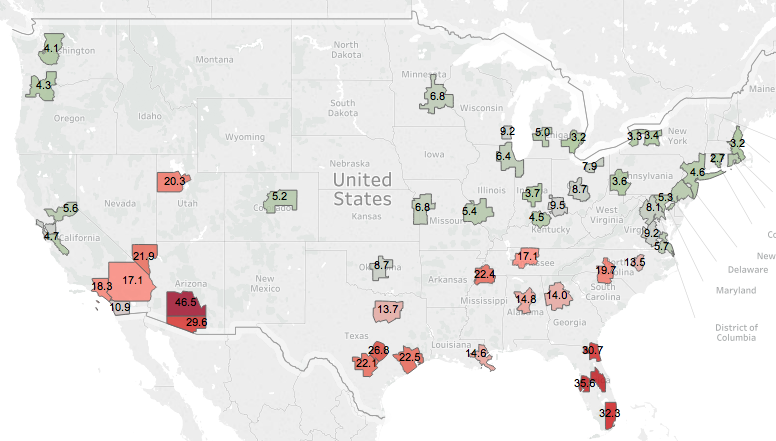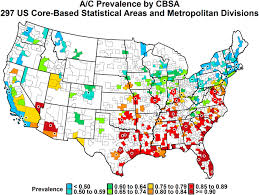The pandemic is exploding in Sunbelt Cities, from the Carolinas to California
Covid-19 is subdued in the North and surging in the South
Hotter southern temperatures and a move indoors, coupled with looser reopening regulations, may explain the Southern surge
In June, there’s been a dramatic change in the geography of the Covid-19 pandemic. For a long time, as we’ve noted at City Observatory, the Covid-19 pandemic has been centered in the Northeast Corridor. New York City is the nation’s hardest hit metro area, and metros from Washington to Boston have had the highest rates of prevalence of Covid-19 cases per capita.
But as the pandemic has surged in the past month, its been in an entirely different geography. There’s an unmistakeable regional pattern: Covid-19 cases are exploding in metro areas in the most southerly parts of the United States from coast-to-coast. Meanwhile the pandemic’s growth is either slowing or subdued in the nation’s northerly metro areas.
A map showing the the number of new cases per day, per 100,000 population for the nation’s 53 largest metropolitan areas clearly illustrates this North/South divide. Here’s the data for the week ending June 28.
 Metros colored red have the highest rates of new Covid-19 cases per capita in the past week; those colored green have the lowest rates. There’s an unmistakeable regional pattern. Every metro but one (Oklahoma City) below the 36th parallel (roughly the southern boundaries of Virginia, Kentucky, Kansas, Colorado and Utah), has a rate higher than the median for large metro areas; every metro but one above that line (Salt Lake City) has a rate of new cases per capita that is higher than the national median.
Metros colored red have the highest rates of new Covid-19 cases per capita in the past week; those colored green have the lowest rates. There’s an unmistakeable regional pattern. Every metro but one (Oklahoma City) below the 36th parallel (roughly the southern boundaries of Virginia, Kentucky, Kansas, Colorado and Utah), has a rate higher than the median for large metro areas; every metro but one above that line (Salt Lake City) has a rate of new cases per capita that is higher than the national median.
This is a dramatic reversal of the pattern of the pandemic from just six weeks ago. In Mid-May, virtually every large Southern metro had a prevalence of the disease that was below the median for all metro areas. Only New Orleans was a true hotspot, and only Miami had a slightly higher than average rate of cases per capita. Other southern metros (Jacksonville, Orlando, Tampa, Phoenix, Tucson) had among the lowest prevalence of Covid-19 per cases of any metros in the nation.
Could hot weather and air conditioning be making this worse?
There are many possible theories for the recent surge in Covid-19 in some states. Many states in the South, notably Florida and Texas, have been among those who were earliest to loosen their Stay-at-Home orders. That’s likely a major contributor to the surge in many of these cities.
But climatic differences may figure in the variance as well. The available scientific data on the spread of Covid-19 suggests that prolonged exposure to infected persons in enclosed environments is the principal means of viral transmission. In the South, as the weather gets progressively hotter in May and June, its likely that, especially relative to other people in the United States, Southerners spend relatively more time indoors.
The prevalence of air conditioning in US homes is a good marker of the places where people spend a good deal of their time in the summer indoors. The geographic pattern of accelerating Covid-19 infections matches almost exactly the prevalence of air conditioning in the US. This theory also matches with a couple of other observations: that the disease has accelerated sharply in Phoenix and Tucson (two places with below average rates of incidence in April), and in California, the disease has spread more rapidly in Southern California than in Northern California.
The point here isn’t that air conditioning causes the spread of the virus, but rather that hot temperatures lead people to spend more time in enclosed spaces when they socialize with others.
Metro Areas ranked by growth in Covid-19 cases per capita
Here we’ve ranked the 53 largest US metro areas according to their increase in cases per 100,000 population in the week ending June 28. Data are from The New York Times.


